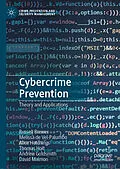Autorentext
Russell Brewer is Senior Lecturer in the School of Social Sciences at the University of Adelaide, Australia.
Inhalt
Series Editor Preface
CHAPTER 1: SETTING THE SCENE
Introduction
Approaches to crime prevention
Factors associated with cyber-dependent offending
Parameters of the review
Overview of the book
References
PART I: PRIMARY FORMS OF PREVENTION
CHAPTER 2: SITUATIONAL CRIME PREVENTION
Introduction
Theoretical underpinnings of the intervention
Current applications
Evidence base for the intervention
Future applications and adaptations to digital contexts
References
CHAPTER 3: UNIVERSAL COMMUNICATION STRATEGIES
Introduction
Theoretical underpinnings of the intervention
Current applications
Evidence base for intervention
Future applications and adaptations to digital contexts
References
PART II: SECONDARY FORMS OF PREVENTION
CHAPTER 4: EDUCATIONAL WORKSHOPS
Introduction
Theoretical underpinnings of the intervention
Current applications
Evidence base for intervention
References
CHAPTER 5: MENTORING PROGRAMS
Introduction
Theoretical underpinnings of the intervention
Current applications
Evidence base for the intervention
Future applications and adaptations to digital contexts
References
CHAPTER 6: TARGETED WARNINGS AND POLICE CAUTIONS
Introduction
Current applications
Evidence base for the intervention
Future applications and adaptations to digital contexts
References
PART III: TERTIARY FORMS OF PREVENTION
CHAPTER 7: POSITIVE DIVERSIONS
Introduction
Theoretical underpinnings of the intervention
Current applications
Evidence base for intervention
Future applications and adaptations to digital contexts
References
CHAPTER 8: RESTORATIVE JUSTICE
Introduction
Theoretical underpinnings of the intervention
Current applications
Evidence base for intervention
Future applications and adaptations to digital contexts
References
CHAPTER 9: DESIGNING AND EVALUATING CRIME PREVENTION SOLUTIONS FOR THE DIGITAL AGE
Navigating the cybercrime intervention minefield
Selecting the appropriate study design
Sourcing the best poss...
